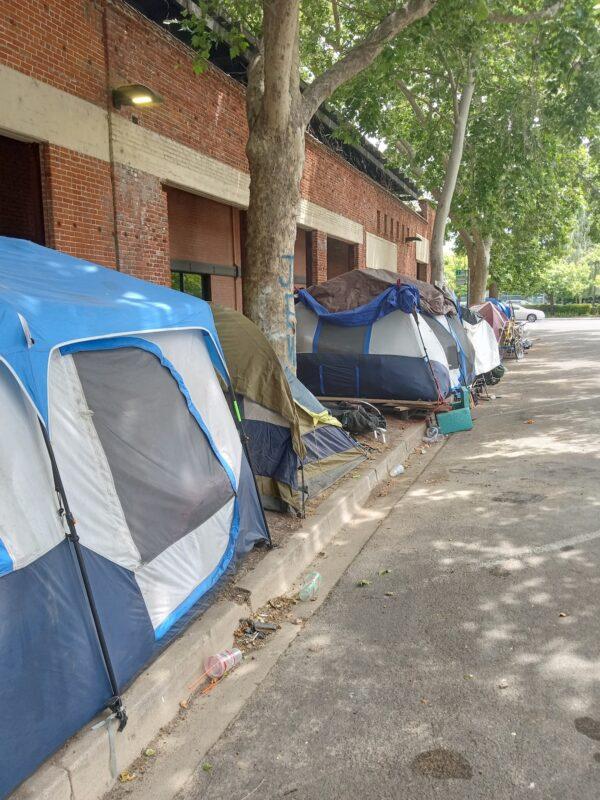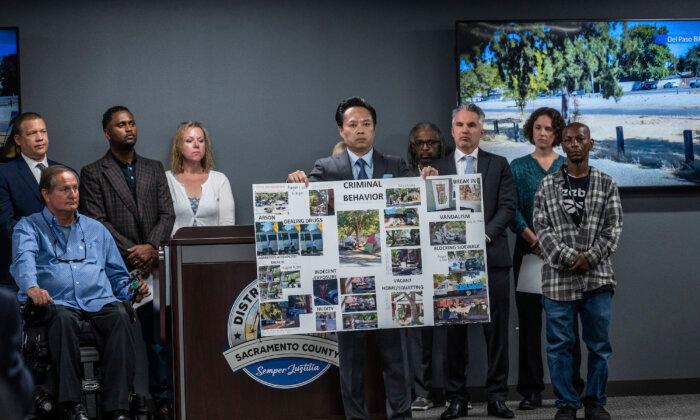According to the agency, the city and county have about 4,000 people who are chronically homeless, meaning they have been unhoused for more than a year and have a disability, such as mental illness, a substance use disorder, or a physical disability.
Ranked first was the city of Los Angeles and Los Angeles County with more than 30,000 such individuals; New York City was second with a little more than 4,500, according to counts taken in January 2023.
Sacramento also had the fifth-most unsheltered homeless in the nation—72 percent of its approximate 9,200 homeless population—and the four locations ahead of it are also in California.
According to some, a lot has changed in the past decade. They say the area they love is being overrun by violent, drug-addicted homeless people, which has resulted in closing storefronts, unsafe streets, and inaccessible public spaces.
“We’ve had huge explosions of camps, drug use, paraphernalia, crime, bike chop shops, the whole deal,” Kristina Rogers, president of the neighborhood association of Land Park, located within a mile of the state Capitol building—told The Epoch Times in a recent interview.
A resident for more than 20 years, Ms. Rogers said she got involved as a community advocate about eight years ago, which is when she said things began to get bad.
“I was driving with my daughter and I saw this young woman who had needle marks all over her arms and legs and was walking down the street like a zombie, my daughter saw her, and I was just horrified ... so that woke me up a little bit,” she said.

After seeing growing concerns from neighbors posting on Next Door, a neighborhood networking app, she asked city leaders for help but said she was ignored by most.
“They really weren’t being proactive about finding out what the problem was or solving it,” she said.
According to Ms. Rogers, her nonprofit association has brought in local police, drug enforcement officers, and city councilors to help with the issues. The association currently has about 300 members.
One statewide policy that worsened the issue, according to Ms. Rogers, is the 2014 passing of Proposition 47, which changed nonviolent property crimes below $950 and simple drug possession from felonies to misdemeanors. Two years after it passed, she said, is when she noticed a spike in crime.
New storefronts 20 years ago have since been dilapidated, such as a Walgreens, Starbucks, and Jamba Juice. All except Walgreens are now closed, overrun by homeless people, according to Ms. Rogers, who said she used to frequent Jamba Juice with her two children.
“There have been a lot of local news stories about it because there’s constant drug activity, misbehavior in the parking lot,” she said. “When the mayor or the city says, ‘We’re trying to deal with the drug issues’ and ’We’re trying to deal with the crime,' you go there and tell me if they’re doing that, because that was supposed to be the revitalization of Broadway 20 years ago.”
She said that on a biking and walking trail near her home, needles, sex toys, homeless vagrants high on meth, and on one occasion a roasted half-eaten skunk, have all been spotted. All of it has led her to start thinking about moving, which, she said, would be difficult.
Why Sacramento?
According to the Sacramento Housing and Redevelopment Agency, the city’s housing authority, there are at least 1,600 community services in the Sacramento area for emergency housing, food, counseling, and employment.The abundance of services, combined with lax laws regarding the homeless, has created a welcoming atmosphere for them, some residents say. They argue that laws should apply the same to the homeless as they do to tax-paying residents.
“I would say probably my biggest problem with this whole situation is our city is not equally enforcing the law. And I don’t think that is what our democracy is based on,” Amy Gardner, founder of Midtown-East Sac Advocates—a group of 300 community advocates who rent or own homes and businesses in the city—told The Epoch Times.

She said the city’s homeless often aren’t subject to the same rules as homeowners.
“Say I had an RV, and I parked it in front of my house. If I didn’t have the current registration, I’m pretty sure within a week, if not less, code enforcement would be in front of my door ticketing my RV,” she said. “If I’m known to be living in my RV, and I am parked with expired registration, maybe no license plate, or maybe an out-of-state license plate that’s expired, nothing happens.”
When the law isn’t equally applied, it can hurt law-abiding citizens, such as the disabled people who are blocked from the city’s sidewalks by homeless encampments, she said.
In October 2023, a class-action lawsuit was filed against the city and county over American Disability Act violations, with some disabled residents testifying to how encampments have blocked their access to city sidewalks, facilities, and services.
Attorneys wrote in the lawsuit that sidewalks—especially in busy business corridors—don’t comply with federal regulations “because they are blocked by tent encampments and attendant debris (often including toxic and used hypodermic needles), and unleashed animals rendering the sidewalks inaccessible, dangerous, and unsanitary,” for those with mobility disabilities.
Facing political pressure, Sacramento has adopted some ordinances that bar encampments in specific areas but left numerous untouched, the lawsuit alleges.
Some local officials have also stepped up to help pass some restrictive ordinances, such as one that bars homeless people from lying within four feet of buildings, and another that bars the same from within 500 feet of K–12 school facilities. Ms. Gardner, Ms. Rogers, and other community leaders say they are rallying residents to push for the new laws.
“So we’re getting together, we’re getting community support for some of these things,” Ms. Gardner said.

That played a part in the recent influx of homeless people, Ms. Gardner said.
“You saw kind of overnight, huge encampments build up, especially with the ones under the underpasses,” she said.
Like in some other areas, in Sacramento, food, tents, sleeping bags, clothing, and even needles and crack pipes are provided to the homeless, which some argue does more harm than good.
Ms. Gardner said she has personally received more than 300 syringes and a free crack pipe from social workers in the city.
Police Can’t Enforce the Law
Similarly, because of a lack of action from the city, Sacramento County District Attorney Thien Ho filed a 48-page lawsuit against Sacramento in December 2023 for allegedly allowing the homeless to endanger public health, obstruct access to public spaces—such as parks and sidewalks—and pollute waterways.“The city’s refusal to maintain the public property under its control and failure to enforce its laws and local ordinances thereon facilitates and perpetuates a public nuisance,” a portion of the lawsuit reads.
He additionally said the homeless camps’ polluting public water with trash and feces violates a section of the state’s Fish and Game Code, which prohibits polluting state waters, among other issues.

When reached for comment, he said he couldn’t speak because of pending litigation against the city, but Yolo County District Attorney Jeff Reisig—who oversees Sacramento’s west side and other cities to the west—told The Epoch Times that California’s soft stance on drugs is responsible for the influx of homeless people in the past 10 years.
He said after voters passed Proposition 47, drugs, crime, and homelessness quickly increased as possession of drugs such as heroin, methamphetamine, cocaine, and fentanyl were no longer felonies.
“It took them and made them misdemeanors, ticket offenses, citation offenses, the kinds of crimes that are pretty [minor] and [the] result is nobody actually being arrested. And more importantly, no real consequence,” he said.
According to point-in-time count estimates from the Department of Housing and Urban Development, homelessness increased in California by 65 percent between 2014—the year Prop 47 was passed—and 2023.
“The new laws may have taken away an effective channel through which some homeless would have been able to access and complete drug treatment,” researchers said in the study.
First elected in 2006, Mr. Reisig is one of California’s longest-serving district attorneys. He said that based on his experience, “the homeless crisis is almost entirely driven by an addiction crisis,” not a housing crisis as some state leaders—such as the governor and California Attorney General Rob Bonta—continue to say.
But Mr. Reisig said that under Proposition 47, police essentially have their hands tied, and addicts are often choosing to stay on the streets because accepting services is voluntary. Police not enforcing open-air use of drugs only adds to the problem.
Every night in Yolo County, shelter beds are empty and homeless services go unused because those on the streets won’t willingly accept help when high on drugs, with services, food, and cheap drugs at their disposal, according to Mr. Reisig.
“They just have no incentive. They’re on the streets. Drugs are cheap. They can sleep wherever they want. Basically, they can steal to support their habit,” he said.
With a family member of his own on the streets, California’s broken laws are “incredibly frustrating,” he said.
Internal Conflict in Sacramento
In Mr. Ho’s lawsuit, he cited multiple occasions in the past few years on which Mayor Darrell Steinberg and Councilwoman Katie Valenzuela allegedly have prevented enforcement action against the homeless, action on illegally parked RVs, or clearing encampments. In the suit, Mr. Ho claims that the mayor, in 2019, stopped the clearing of an RV encampment under what has since been called “Darrell’s Directive,” resulting in worsening conditions.In June 2023, a Sacramento Superior Court judge sent a letter to the city, alleging daily incidents of “physical and verbal assault, public sex acts, open fires, nudity, urinating and defecating on walkways,” near the courthouse, which has interfered with residents’ “access to justice.”
Also in June 2023, Mr. Ho sent his own letter to the city alleging that employees from his office have been assaulted and threatened, while the three blocks encompassing the courthouse are surrounded by violent homeless people who sometimes engage in lewd behavior.
He asked the city to help get the homeless off the streets and into shelters, to which the mayor allegedly agreed. But according to the lawsuit, months later nothing changed and, in fact, things only worsened, with another employee threatened and one woman sexually harassed since then.

A public survey by the district attorney’s office with more than 3,000 responses found that many residents have been assaulted at gunpoint by alleged homeless people; a girls’ soccer game was postponed because of syringes on the field, and children have to walk through feces and urine on their ways to school, Mr. Ho said in the lawsuit.
Sacramento resident John Morales told The Epoch Times that after being ignored by the city, he and others reported their own encounters to Mr. Ho for the lawsuit.
Change on the Horizon?
According to a spokesperson for the city, new shelters, a partnership with the county, and various interdepartmental efforts to help “resolve the hardships faced by unsheltered individuals,” while maintaining clean and safe neighborhoods are ongoing.Also, city workers have helped move homeless people 1,700 times since then to enforce city ordinances such as keeping sidewalks clear and creating “buffer zones” near “critical infrastructure” such as schools, fire departments, courthouses, train tracks, water sources, and hospitals to name a few, according to the city.
“The City of Sacramento remains committed to providing support to its most vulnerable residents while also enforcing its laws and ordinances,” a city spokesperson told The Epoch Times in an email.
A spokesperson for the county didn’t respond to a request for comment.







